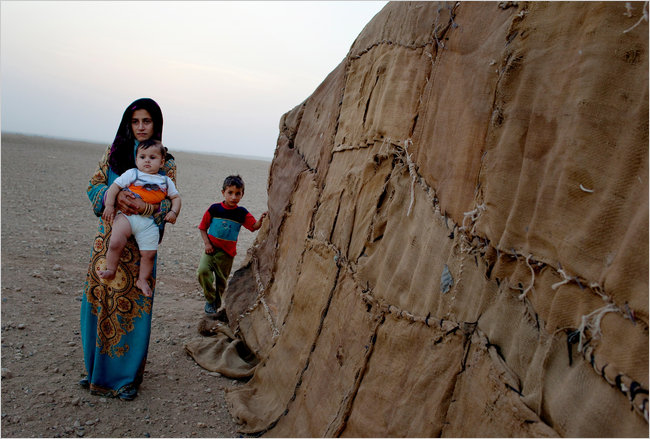Drought withers lush farmlands in Syria
By ROBERT F. WORTH
Published: October 13, 2010 AR RAQQAH, Syria — The farmlands spreading north and east of this Euphrates River town were once the breadbasket of the region, a vast expanse of golden wheat fields and bucolic sheep herds. Now, after four consecutive years of drought, this heartland of the Fertile Crescent — including much of neighboring Iraq — appears to be turning barren, climate scientists say. Ancient irrigation systems have collapsed, underground water sources have run dry and hundreds of villages have been abandoned as farmlands turn to cracked desert and grazing animals die off. Sandstorms have become far more common, and vast tent cities of dispossessed farmers and their families have risen up around the larger towns and cities of Syria and Iraq. “I had 400 acres of wheat, and now it’s all desert,” said Ahmed Abdullah, 48, a farmer who is living in a ragged burlap and plastic tent here with his wife and 12 children alongside many other migrants. “We were forced to flee. Now we are at less than zero — no money, no job, no hope.” The collapse of farmlands here — which is as much a matter of human mismanagement as of drought — has become a dire economic challenge and a rising security concern for the Syrian and Iraqi governments, which are growing far more dependent on other countries for food and water. Syria, which once prided itself on its self-sufficiency and even exported wheat, is now quietly importing it in ever larger amounts. The country’s total water resources dropped by half between 2002 and 2008, partly through waste and overuse, scientists and water engineers say. … The four-year drought in Syria has pushed two million to three million people into extreme poverty, according to a survey completed here this month by the United Nations special rapporteur on the right to food, Olivier De Schutter. Herders in the country’s northeast have lost 85 percent of their livestock, and at least 1.3 million people have been affected, he reported. An estimated 50,000 more families have migrated from rural areas this year, on top of the hundreds of thousands of people who fled in earlier years, Mr. De Schutter said. Syria, with a fast-growing population, has already strained to accommodate more than a million Iraqi refugees in the years since the 2003 invasion. … Droughts have always taken place here, but “the regional climate is changing in ways that are clearly observable,” said Jeannie Sowers, a professor at the University of New Hampshire who has written on Middle East climate issues. “Whether you call it human-induced climate change or not, much of the region is getting hotter and dryer, combined with more intense, erratic rainfall and flooding in some areas. You will have people migrating as a result, and governments are ill prepared.” …
